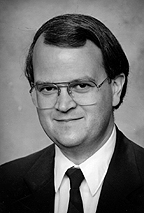


"One of the main laws they learn is the benefits of a diversified portfolio," says Roley. "They see the benefits in the short run and the long run."
"They understand the basic mechanism of how a portfolio works," adds Ferson. "What is diversification? When does it work for better or for worse? And what are the risks in the context of a portfolio."
For example, holding Microsoft stock in a portfolio already heavily invested in computer stocks is riskier that the same amount of Microsoft stock in a more evenly spread portfolio.
Both professors have students create fictitious investment portfolios. Ferson adds a touch of drama to his financial labs: He pretends he is one of three characters whom students must interview and then design the perfect portfolio.
"Joe Fastback" is a young M.B.A. just out of school with a well-paying job as a sales manager. He has just inherited a chunk of money from his grandmother. "Sam Sedate" is a middle-aged insurance officer with two children getting ready for college and a Keogh retirement plan. "Phil Coot" is a retired engineer from Skybarge Aerospace who has a pension and some assets.
Ferson then grades the portfolios, "not on how the portfolio performs, but on the logic of the choices," he explains.
When he took Ferson's course, business senior Phillip Yin and five other students created their own mock mutual fund, which they called the "Cascade Fund." "We focused on undervalued stock in high tech and telecommunications industries," Yin recalls. Over a three month period, Yin says, the fund achieved a 6 to 7 percent rate of return.
In Roley's courses students build a portfolio and also track an individual stock through the quarter. "For their individual stock, they seem to favor local stocks--Microsoft, Boeing, Nordstrom, Weyerhaeuser--and lots of beer companies. I long ago learned that the New York Stock Exchange symbol of Anheiser-Busch was `BUD,' " he says.
Ferson's students also tend to have a "home bias." "That's nothing unusual, since there is a home bias in the investment world in general," he notes. "Investors favor equities in their own country relative to other countries, despite the returns. This is true in America and in Japan. It is a hot research topic right now."
Making a Killing--Or Getting Killed?
Mission Impossible:Predicting Future Trends
The Feeling is Mutuals: Funds Aren't Such Bad
Performers
Top 10 Financial Web Sites
Business School Home Page
Send a letter to the editor at columns@u.washington.edu.